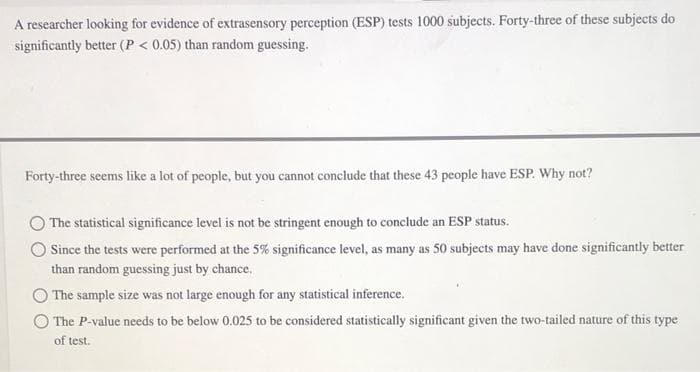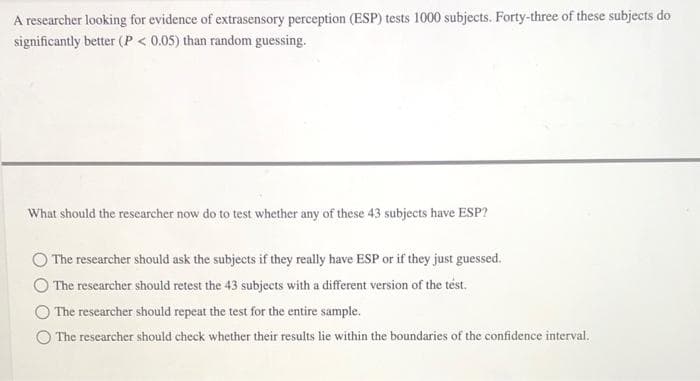A researcher looking for evidence of extrasensory perception (ESP) tests 1000 subjects. Forty-three of these subjects do significantly better (P < 0.05) than random guessing. What should the researcher now do to test whether any of these 43 subjects have ESP? The researcher should ask the subjects if they really have ESP or if they just guessed. The researcher should retest the 43 subjects with a different version of the test. The researcher should repeat the test for the entire sample. O The researcher should check whether their results lie within the boundaries of the confidence interval.
A researcher looking for evidence of extrasensory perception (ESP) tests 1000 subjects. Forty-three of these subjects do significantly better (P < 0.05) than random guessing. What should the researcher now do to test whether any of these 43 subjects have ESP? The researcher should ask the subjects if they really have ESP or if they just guessed. The researcher should retest the 43 subjects with a different version of the test. The researcher should repeat the test for the entire sample. O The researcher should check whether their results lie within the boundaries of the confidence interval.
Holt Mcdougal Larson Pre-algebra: Student Edition 2012
1st Edition
ISBN:9780547587776
Author:HOLT MCDOUGAL
Publisher:HOLT MCDOUGAL
Chapter11: Data Analysis And Probability
Section: Chapter Questions
Problem 8CR
Related questions
Question

Transcribed Image Text:A researcher looking for evidence of extrasensory perception (ESP) tests 1000 subjects. Forty-three of these subjects do
significantly better (P < 0.05) than random guessing.
Forty-three seems like a lot of people, but you cannot conclude that these 43 people have ESP. Why not?
The statistical significance level is not be stringent enough to conclude an ESP status.
Since the tests were performed at the 5% significance level, as many as 50 subjects may have done significantly better
than random guessing just by chance.
The sample size was not large enough for any statistical inference.
The P-value needs to be below 0.025 to be considered statistically significant given the two-tailed nature of this type
of test.

Transcribed Image Text:A researcher looking for evidence of extrasensory perception (ESP) tests 1000 subjects. Forty-three of these subjects do
significantly better (P < 0.05) than random guessing.
What should the researcher now do to test whether any of these 43 subjects have ESP?
The researcher should ask the subjects if they really have ESP or if they just guessed.
The researcher should retest the 43 subjects with a different version of the test.
The researcher should repeat the test for the entire sample.
The researcher should check whether their results lie within the boundaries of the confidence interval.
Expert Solution
This question has been solved!
Explore an expertly crafted, step-by-step solution for a thorough understanding of key concepts.
This is a popular solution!
Trending now
This is a popular solution!
Step by step
Solved in 4 steps

Recommended textbooks for you

Holt Mcdougal Larson Pre-algebra: Student Edition…
Algebra
ISBN:
9780547587776
Author:
HOLT MCDOUGAL
Publisher:
HOLT MCDOUGAL

Glencoe Algebra 1, Student Edition, 9780079039897…
Algebra
ISBN:
9780079039897
Author:
Carter
Publisher:
McGraw Hill

College Algebra (MindTap Course List)
Algebra
ISBN:
9781305652231
Author:
R. David Gustafson, Jeff Hughes
Publisher:
Cengage Learning

Holt Mcdougal Larson Pre-algebra: Student Edition…
Algebra
ISBN:
9780547587776
Author:
HOLT MCDOUGAL
Publisher:
HOLT MCDOUGAL

Glencoe Algebra 1, Student Edition, 9780079039897…
Algebra
ISBN:
9780079039897
Author:
Carter
Publisher:
McGraw Hill

College Algebra (MindTap Course List)
Algebra
ISBN:
9781305652231
Author:
R. David Gustafson, Jeff Hughes
Publisher:
Cengage Learning